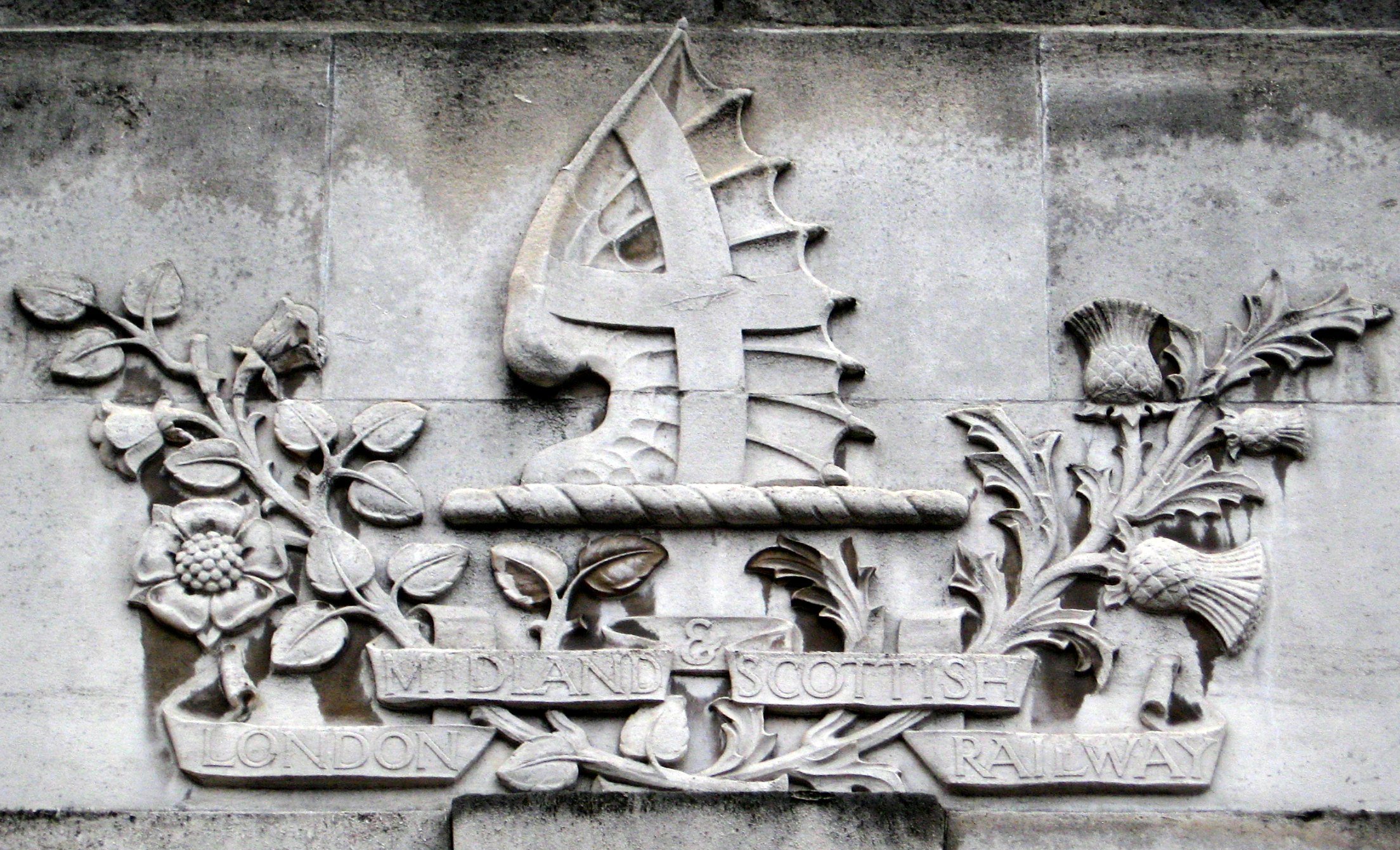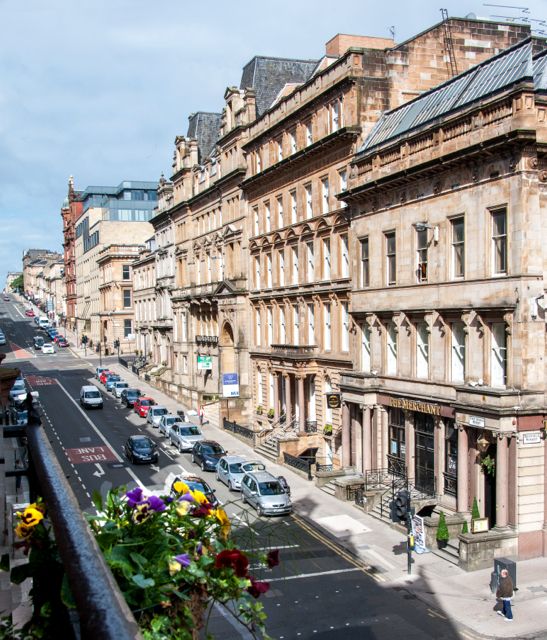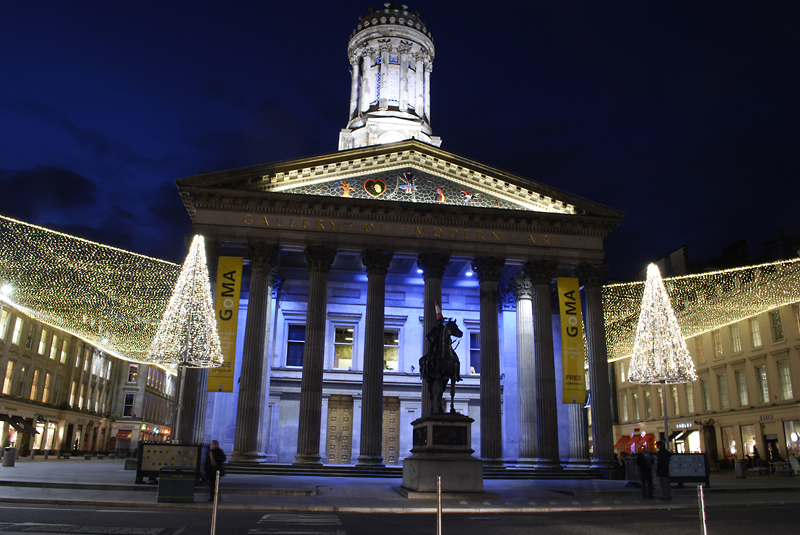|
Buchanan Street
Buchanan Street is one of the main shopping thoroughfares in Glasgow, the largest city in Scotland. It forms the central stretch of Glasgow's famous shopping district with a generally more upmarket range of shops than the neighbouring streets: Argyle Street, and Sauchiehall Street. History Buchanan Street was first feued in 1777 and named after a wealthy Tobacco Lord, plantation owner and former Lord Provost of Glasgow, Andrew Buchanan of Buchanan, Hastie, & Co. He was proprietor of the ground on which it was formed from Argyle Street as far north as Gordon Street. Andrew had died in 1759 and his tobacco empire was inherited by his son James Buchanan of Drumpellier (also twice Lord Provost of Glasgow). The family made huge losses following the American Revolution of 1776, losing all their plantations in Virginia. The family members moved into textile manufacturing and industrial expansion. Sale of the land was probably at least in part to offset these initial losses. Pal ... [...More Info...] [...Related Items...] OR: [Wikipedia] [Google] [Baidu] |
Statue Of Donald Dewar
A statue of the Scottish politician Donald Dewar stands on Buchanan Street in Glasgow city centre. The statue was unveiled on 7 May 2002 by the Prime Minister of the United Kingdom, Tony Blair. It was sculpted by Kenny Mackay. The statue is 9 feet in height. Dewar is depicted wearing spectacles and his "characteristic stoop and crumpled suit". The statue was unveiled on 7 May 2002 by the Prime Minister of the United Kingdom, Tony Blair in front of a crowd of several hundred people. At the unveiling of the statue Blair said that Dewar's " ... compassion, his fundamental decency and his deep sense of social justice defined his entire approach as a politician" and described him as a "transforming moderate". The former leader of Scottish Labour, Wendy Alexander Wendy Alexander (born 27 June 1963) is a retired Scottish politician and the former Member of the Scottish Parliament (MSP) for Paisley North. She held various Scottish Government cabinet posts and was the Leader of the L ... [...More Info...] [...Related Items...] OR: [Wikipedia] [Google] [Baidu] |
James Buchanan Of Drumpellier
James Buchanan of Drumpellier (1726–1786) was an 18th-century tobacco merchant who twice served as Lord Provost of Glasgow from 1768 to 1770 and 1774 to 1776. Life He was born at Long Croft in Glasgow (now known as Virginia Street) in 1726 the son of Andrew Buchanan of Drumpellier and his wife Marion Montgomery. When James was a teenager his father served as Lord Provost of Glasgow. Although he inherited his father's tobacco plantations and estates, including Drumpellier on his father's death in 1759, he was ruined in 1777 following the American Revolution. He sold the bulk of his estates to his cousin, Andrew Stirling (of William Stirling & Sons). The estate was reacquired by James' nephew, David Buchanan in 1808 (later known as David Buchanan Carrick). In 1777 Buchanan Street in Glasgow was built on lands he inherited from his father, and is named after his family. Around 1780 he seems to have relocated to Edinburgh. He is listed as a commissioner (probably working for t ... [...More Info...] [...Related Items...] OR: [Wikipedia] [Google] [Baidu] |
Glasgow Caledonian University
Glasgow Caledonian University ( gd, Oilthigh Chailleannach Ghlaschu, ), informally GCU, Caledonian or Caley, is a public university in Glasgow, Scotland. It was formed in 1993 by the merger of The Queen's College, Glasgow (founded in 1875) and Glasgow Polytechnic (founded in 1991). In June 2017, the university's New York partner institution, which was founded in 2013, was granted permission to award degrees in the state, the first higher education institution founded by a foreign university to achieve this status. History The university traces its origin from ''The Queen's College, Glasgow'' (founded 1875), and the ''Glasgow College of Technology'' (founded 1971). The Queen's College, which specialised in providing training in domestic science, received the royal accolade of being named after Queen Elizabeth in its centenary celebrations in 1975. Queen Elizabeth was, herself, patron of the college since 1944. Glasgow Polytechnic, which was one of the largest central institut ... [...More Info...] [...Related Items...] OR: [Wikipedia] [Google] [Baidu] |
British Railways
British Railways (BR), which from 1965 traded as British Rail, was a state-owned company that operated most of the overground rail transport in Great Britain from 1948 to 1997. It was formed from the nationalisation of the Big Four (British railway companies), Big Four British railway companies, and was privatisation of British Rail, privatised in stages between 1994 and 1997. Originally a trading brand of the Railway Executive of the British Transport Commission, it became an independent statutory corporation in January 1963, when it was formally renamed the British Railways Board. The period of nationalisation saw sweeping changes in the railway. A process of dieselisation and Railway electrification in Great Britain, electrification took place, and by 1968 steam locomotives had been entirely replaced by diesel and electric traction, except for the Vale of Rheidol Railway (a narrow-gauge railway, narrow-gauge tourist line). Passenger train, Passengers replaced freight train, ... [...More Info...] [...Related Items...] OR: [Wikipedia] [Google] [Baidu] |
London Midland And Scottish Railway
The London, Midland and Scottish Railway (LMSIt has been argued that the initials LMSR should be used to be consistent with LNER, GWR and SR. The London, Midland and Scottish Railway's corporate image used LMS, and this is what is generally used in historical circles. The LMS occasionally also used the initials LM&SR. For consistency, this article uses the initials LMS.) was a British railway company. It was formed on 1 January 1923 under the Railways Act of 1921, which required the grouping of over 120 separate railways into four. The companies merged into the LMS included the London and North Western Railway, Midland Railway, the Lancashire and Yorkshire Railway (which had previously merged with the London and North Western Railway on 1 January 1922), several Scottish railway companies (including the Caledonian Railway), and numerous other, smaller ventures. Besides being the world's largest transport organisation, the company was also the largest commercial enter ... [...More Info...] [...Related Items...] OR: [Wikipedia] [Google] [Baidu] |
Caledonian Railway
The Caledonian Railway (CR) was a major Scottish railway company. It was formed in the early 19th century with the objective of forming a link between English railways and Glasgow. It progressively extended its network and reached Edinburgh and Aberdeen, with a dense network of branch lines in the area surrounding Glasgow. It was absorbed into the London, Midland and Scottish Railway in 1923. Many of its principal routes are still used, and the original main line between Carlisle and Glasgow is in use as part of the West Coast Main Line railway (with a modified entry into Glasgow itself). Introduction In the mid-1830s, railways in England evolved from local concerns to longer routes that connected cities, and then became networks. In Scotland it was clear that this was the way forward, and there was a desire to connect the Central Belt to the incipient English network. There was controversy over the route that such a line might take, but the Caledonian Railway was formed on ... [...More Info...] [...Related Items...] OR: [Wikipedia] [Google] [Baidu] |
Buchanan Street Railway Station
Buchanan Street station was the least known of Glasgow's four main terminus railway stations, the other three being , and . It was to the north-west of Queen Street station and served the north of Scotland. History Constructed in 1849 by the Caledonian Railway Company as its main terminus for the city, the original station buildings consisted of supposedly temporary wooden structures, which lasted until the 1930s. A goods station at the site opened in 1850. Services ran primarily northbound, to Aberdeen, Perth and Stirling and other destinations. The station was earmarked for closure and replacement in the " Bruce Report" about how to redevelop Glasgow in the post-Second World War World War II or the Second World War, often abbreviated as WWII or WW2, was a world war that lasted from 1939 to 1945. It involved the World War II by country, vast majority of the world's countries—including all of the great power ... period. The plan included replacing Buchanan ... [...More Info...] [...Related Items...] OR: [Wikipedia] [Google] [Baidu] |
Blythswood Square
Blythswood Square is the Georgian square on Blythswood Hill in the heart of the City of Glasgow, Scotland. The square is part of the 'Magnificent New Town of Blythswood' built in the 1800s on the rising empty ground west of a very new Buchanan Street. These open grounds were part of the vast Lands of Blythswood stretching to the River Kelvin acquired by the Douglas-Campbell family in the 17th century.''Glasgow Past and Present''; by Senex and others, three volumes published in 1884 The Blythswood district became a Conservation Area in 1970, because of its important architectural and historic buildings. The square is one of the largest residential developments on Blythswood Hill on the of ground purchased in 1802 from the Campbells of Blythswood by The Great Improver - William Harley textile manufacturer and merchant. Harley also owned the adjacent mansion and 10-acre estate of Willow Bank, where he created and opened his Willowbank/Blythswood Pleasure Gardens with view ... [...More Info...] [...Related Items...] OR: [Wikipedia] [Google] [Baidu] |
Blythswood Hill
Blythswood Hill, crowned by the elegance of Blythswood Square, is the wealthiest part of central Glasgow, Scotland. It extends from the west edge of Buchanan Street to Gordon Street and Bothwell Street, Charing Cross, Sauchiehall Street and Garnethill. Developed as the city's wealthiest and healthiest residential area from 1800 onwards, its Georgian and Victorian architecture continues as a Conservation Area of international note. It started as the "Magnificent New Town of Blythswood" becoming an integral part of the city-centre's business and social life. After the Reformation the vast Lands of Blythswood were owned by the distinguished Glasgow merchant family Elphinstone; one descendant George Elphinstone became an MP of the Scots Parliament. Through his daughter it changed to the Douglas-Campbell family during the 17th century. Archibald Campbell, whose son became Lord Blythswood, setting about feuing the lands to developers.''Glasgow Past and Present'', by Senex and ... [...More Info...] [...Related Items...] OR: [Wikipedia] [Google] [Baidu] |
William Harley
William Harley (1767–1829) was a Scottish textile manufacturer and entrepreneur who is known for his early contributions to the city of Glasgow, including the development of the New Town of Blythswood, covering Blythswood Hill, and pioneering hygienic dairy farming. Early life Harley was born in Glen Devon, Scotland, but lost both parents at an early age, so was brought up by his paternal grandmother. He trained as a weaver in Kinross under the employ of his maternal uncle who produced satinet, and then later for his uncle's business in Perth. Ventures In 1789 William Harley moved to Glasgow, becoming a textile manufacturer, employing some 600 handloom weavers in partnership with a fellow member of the Merchants House but soon opened his own business warehouse on the corner of George Square on South Frederick Street. Development of Blythswood By 1802, and now married to Jane Laird of Greenock, his business was so profitable that he purchased a house called Willowba ... [...More Info...] [...Related Items...] OR: [Wikipedia] [Google] [Baidu] |
Royal Scottish Academy Of Music & Drama
The Royal Conservatoire of Scotland ( gd, Conservatoire Rìoghail na h-Alba), formerly the Royal Scottish Academy of Music and Drama ( gd, Acadamaidh Rìoghail Ciùil is Dràma na h-Alba) is a conservatoire of dance, drama, music, production, and film in Glasgow, Scotland. It is a member of the Federation of Drama Schools. Founded in 1847, it has become the busiest performing arts venue in Scotland with over 500 public performances each year. The current principal is American pianist and composer Jeffrey Sharkey. The patron is King Charles III. History The Royal Conservatoire has occupied its current purpose-built building on Renfrew Street in Glasgow since 1988. Its roots lie in several organisations. Officially founded in 1847 by Moses Provan as part of the Glasgow Athenaeum, from an earlier Educational Association grouping, music and arts were provided alongside courses in commercial skills, literature, languages, sciences and mathematics. Courses were open and affordable, in ... [...More Info...] [...Related Items...] OR: [Wikipedia] [Google] [Baidu] |
Royal Exchange Square
The Royal Exchange Square is a public square in Glasgow, Scotland. The square lies between Buchanan Street and Queen Street, opening out Queen Street and Ingram Street to the south of George Square. It is also easily accessible from Buchanan Street on the west side of the square, through two prominent archways at Royal Bank Place. The square is a landmark due to its distinguished architecture which attracts many visitors. It is one of six squares in the city centre. Historical background Tobacco lord William Cunninghame's mansion and gardens fronting Queen Street, and central to the future square, were constructed in 1778 when the wealth of Glasgow soon eclipsed the remainder of Scotland. Five years later the Royal Bank of Scotland opened in Glasgow, being its first ever branch beyond its Edinburgh base. Under its agent, the merchant and philanthropist David Dale, the bank in Glasgow soon exceeded the business volume of the Royal Bank elsewhere, and to reflect its statu ... [...More Info...] [...Related Items...] OR: [Wikipedia] [Google] [Baidu] |




.jpg)





